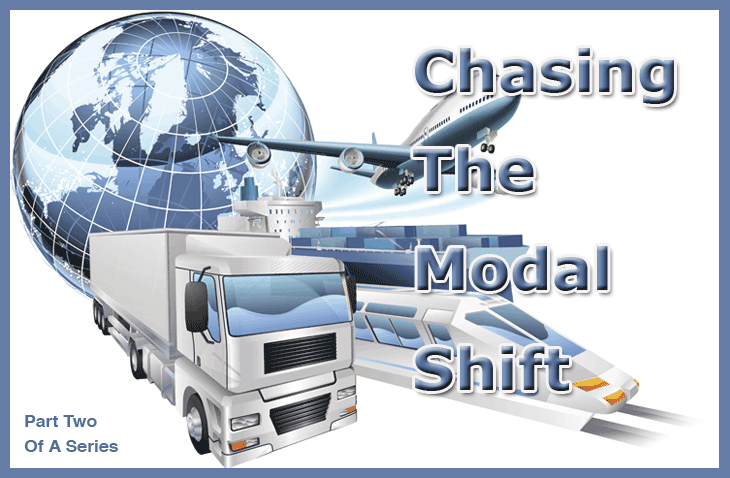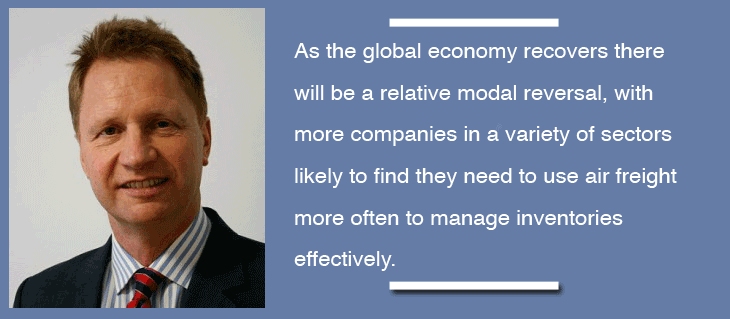
In the years since the
2008 Global Financial Crisis it is has been commonly assumed that there
has been a drift of cargo from air to ocean solutions and, on the Asia-Europe
trade lane, to new and ever improving intermodal solutions via Russia
or Central Asia.
While much of the evidence is circumstantial
and exact data is difficult to come by, a cursory examination of growth
figures for container shipping demand and air freight volumes –
the former has posted regular if slow year-on-year expansion while the
latter has seen negligible or bearish growth on most lanes since 2010
- suggests that cargo drift has been no modal illusion.
Cost cutting was, of course, a key factor:
slow consumer demand from a stricken U.S. economy and troubled Eurozone
meant it was only natural that supply chain organizers did their utmost
to reduce transport outlays.
But with the global economy looking markedly
more perky in the last six months, Flying Typers asked a number
of leading executives whether improving consumer confidence in key Western
markets would boost air freight volumes as the need to for expedited shipments
rose; or whether they thought the lengthy dip suffered by the air cargo
industry in both volume and pricing was indicative of a more fundamental,
long-term modal shift.
 |
Martin Dixon, Director
Research Products at Drewry, was surprisingly upbeat about what air freight
markets may have in store during the coming months.
He believes that recent years have been
marked by a shift from air to ocean, although he said pinpointing the
exact size of the shift was difficult because the volumes were too small
to appear in container shipping statistics.
But Dixon takes the view that as the global
economy recovers there will be a relative modal reversal, with more companies
in a variety of sectors likely to find they need to use air freight more
often to manage inventories effectively.
“We expect some shift back to airfreight
as the global economy recovers,” he told Flying Typers.
“Some
of the shift away from air that we have seen over the past few years has
been the result of cost cutting. Hence, as cost pressures recede, so we
are likely to see greater use of expedited airfreight for traditional
high value, time sensitive commodities such as hi-tech, aerospace, pharma,
fashion and perishables.”
However, he said there have also been other
factors that have contributed to modal shift away from airfreight apart
from simply the desire to squeeze as much cost out of supply chains as
possible. For example, product miniaturization has reduced overall volume
demand for commodities that have traditionally moved by air such as hi
tech consumer goods where high value laptops have been superseded by smart
phones.
“There has also been a longer term
trend whereby companies have just become better at managing their supply
chains and so reduced dependence on expedited freight spend,” he
said. “Meanwhile, traditionally slower modes of transport have become
more efficient and reliable. This is particularly true of land-based modes
such as road and intermodal which has impacted demand for domestic or
intra-regional airfreight.”
He also believes that container shipping
lines have improved performance and made their services more attractive
to shippers. “Ocean carrier service reliability has improved over
the years, assisted by the one-stop shop services offered by the logistics
service providers,” he said. “Developments in reefer technology
have also enabled perishable shelf-life to be extended, so encouraging
some shift from air to sea freight.”
And with lower energy prices in the U.S.,
and rising costs in coastal China, many cargoes that may have previously
been flown could instead soon be manufactured closer to consumer markets,
further diminishing demand for air freight. “Going forward, near
sourcing will challenge wider use of airfreight,” he said.
How much of the cargo lost by the air cargo
sector to ocean and other modes in recent years can be recaptured is,
according to Dixon, harder to forecast. Air should do better as overall
cargo volumes expand, but he also expects the switch of some automotive,
textiles, perishables and pharma commodities that traditionally moved
by air to sea to continue.
SkyKing
For Part I Click Here |


